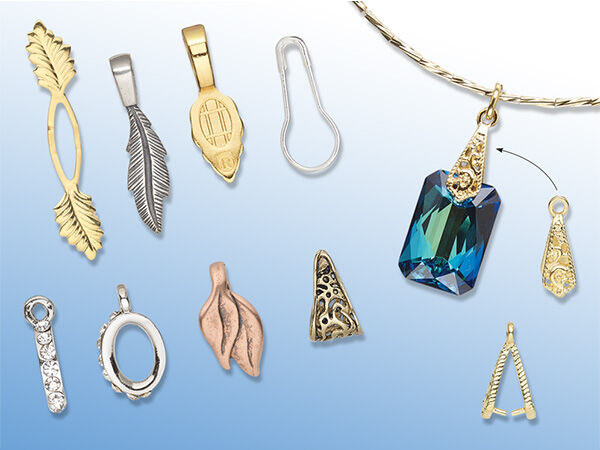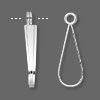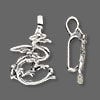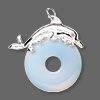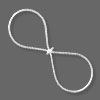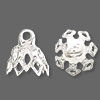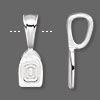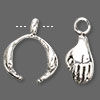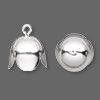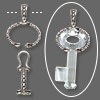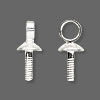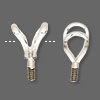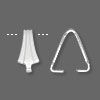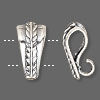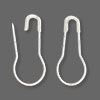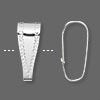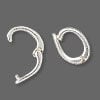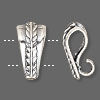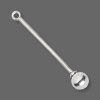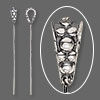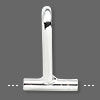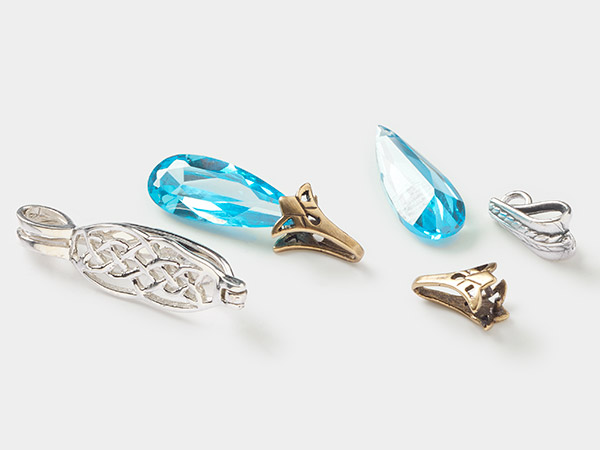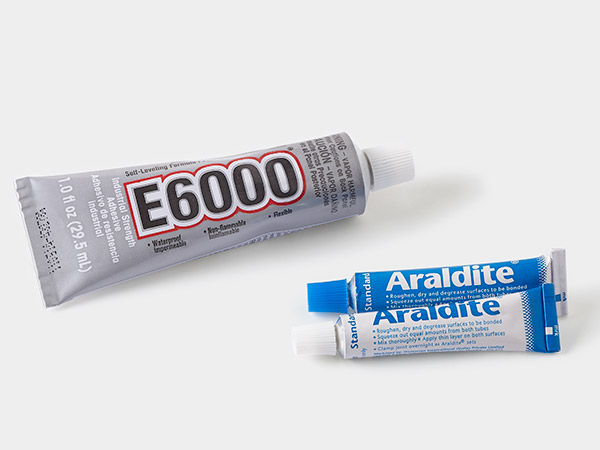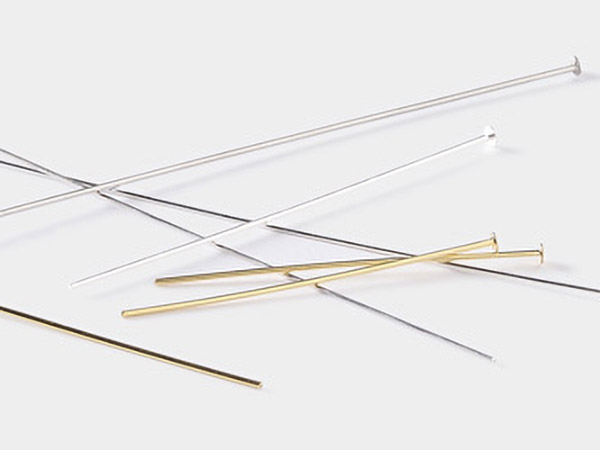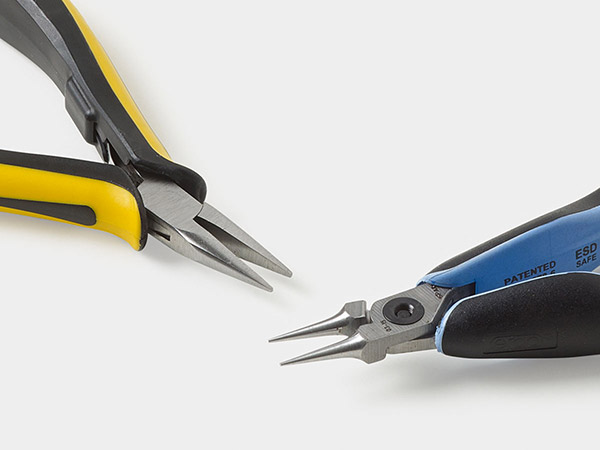A Guide to Bails
Design Idea NA2M
What is the jewelry finding called a "bail"?
It's a jewelry-making finding that transforms a bead, donut, flat-backed component and other pieces into a necklace pendant or drop. Jewelry bails expand design options without metalsmithing or soldering.
Bails for necklaces and other jewelry styles are created from a wide variety of materials (mostly metals such as sterling silver, brass, "pewter," precious gold and more), in a range of sizes and styles.
See which bail works best for what project using this informative resource guide of jewelry bail types:
Jewelry Bails for Donut Focal Components
- A folding donut bail clamps over any small and medium-sized gemstone or glass donut and can be beaded directly into a necklace. These bails are jewelry enhancers, easily hung from chain or cord for a quick-change necklace: remove from chain, open bail, replace donut, close and re-hang.
Casting or Pressure Donut Bails
- A pressure donut bail holds any small and medium-sized donut behind a detailed casting to create a pendant.
- Wire bails turn any donut into an eye-catching pendant. This sterling silver wire piece works especially well for uncalibrated donuts, freeform donuts and go-go shapes.
Jewelry Bails for Other Focal Components, undrilled
- A fold-over bail is manufactured with two flat pads on each end of a straight portion, often with a leaf design. Metal folds in half. Two-part epoxy** or Loctite 454 is used to glue the pads to the item to be suspended. These bails work especially well for irregularly shaped flat items.
- A bell cap can make any object into a drop earring or pendant. Legs of the bell cap are bent to follow the shape of the object and are bonded in place with two-part epoxy** or Loctite 454. Add a jumpring. These bails work especially well for freeform three-dimensional items such as undrilled tumbled stones.
- A flat-backed "Y" bail has double loops to suspend it evenly along stringing wire, cord or chain. Has one pad for attaching an undrilled item (two-part epoxy** or Loctite 454 are recommended glues). An excellent choice to turn cabochons or other flat-backed components into quick pendants.
- Aanraku jewelry bails are copyrighted glue-on bails with a flat area for gluing on an undrilled item (two-part epoxy** or Loctite 454 are recommended glues). Flat area is textured for better adhesion.
- A flat pad glue-on jewelry bail has a large stringing hole and a flat area for attaching an undrilled item. Flat area is textured for better adhesion. Two-part epoxy** or Loctite 454 are recommended glues.
- This bail for necklaces and earrings is a two-sided finding which holds a drilled bead on a added pin or undrilled bead using a combination of pressure and adhesive. Two-part epoxy** or Loctite 454 are recommended glues.
End Caps with Loop and Cord Ends with jumpring
- Findings which allow a bead, component or stringing material to be inserted or otherwise attached inside them. End caps can be used to create drops or to provide a professional attachment to stringing material using two-part epoxy** or Loctite 454. Add a jumpring. These bails work especially well for spherical items.
Jewelry Bails for Half-Drilled Beads and Focal Components
Screw Eyes with jumpring
- Screw eye bails are bonded into the holes of half-drilled items with two-part epoxy** or Loctite 454. Add a jumpring to use as a pendant, dangle or drop.
Upeyes with jumpring
- These glue-on bails for jewelry-making are bonded into the holes of half-drilled items with two-part epoxy** or Loctite 454. Add a jumpring to use as a pendant, dangle or drop.
- This style of glue-on jewelry bail has double loops to suspend it evenly along the stringing wire, cord or chain. Has a vertical peg for gluing into half-drilled beads (two-part epoxy** or Loctite 454 are recommended glues).
Jewelry Bails for Focal Components—Drilled Front to Back
Ice-Pick Bails (also called Pinch Bails or Prong Bails)
- This style of pendant bail has horizontal prongs which are pinched into the hole of a top-drilled bead. For extra security, use a bit of two-part epoxy** or Loctite 454 to secure the prongs in place.
Split Loop/Hidden Loop Pendant Bails
- This style of pendant bail has a wide smooth bail and a split loop--just open, insert wire loop or jumpring and close.
- This style of pin bail is bulb-shaped with round bottoms, ideal for creating removable and interchangeable bails for adding charms, dangles, brooch attachments and more.
Jewelry Bails for Focal Components with Wire Loop or Jumpring Attached
Standard Bails (also called Snap-On Bails)
- These metal bails can be quickly snapped open to make a pendant attachment. Some styles use a magnetic clasp-style loop, some a hinge and a clip--others use simple tension to remain stable.
Interchangeable Hinged Bails (also called Bead Hangers, Strand Hangers or Pearl Enhancers)
- These metal bails open and close with a snap or magnetic closure. The centerpiece is hung from the loop, hole or jumpring at the bottom of the bail for easy transfer from one necklace to another. Ideal for focal pieces that work with different parts of a parure (pah-RUR), or jewelry set, as well as being ideal charm bails.
Split Loop/Hidden Loop Pendant Bails
- These metal bails have a wide smooth stringing hole and a split loop--just open, insert wire loop or jumpring and close.
- This style of pin bail is bulb-shaped with round bottoms, ideal for creating removable and interchangeable bails for adding charms, dangles, brooch attachments and more.
Jewelry Bails for Bead with Fully-Drilled Hole
- Make large-hole beads into pendants, quickly and easily. String bead onto shaft, add a jumpring to the hole on the top. Some styles have twist-off ends or require adhesives, others are just "string and go."
Headpins with jumpring
- When used as a bail finding, headpins turn beads into pendants or pendant drops.
- These bead bails easily connect beads without the use of a jumpring. Add beads, cut the pin to the desired length and make a loop.
Jewelry Bails for Pin or Brooch
- These jewelry bails temporarily change a brooch or pin into a pendant by allowing the pin to be slid through a tube, then latched closed. The brooch can be easily removed from the converter and worn again as a pin. Pin bails are available in both horizontal and vertical styles, with both styles having attached loops for easy hanging. Ideal for focal pieces that work with different parts of a parure (pah-RUR), or jewelry set.
- This style of pin bail is bulb-shaped with round bottoms, ideal for creating removable and interchangeable bails for adding charms, dangles, brooch attachments and more.
**When choosing between 5-minute and 30-minute two-part epoxy, refer to the length of time necessary to complete the entire gluing project. When working on a lengthy individual project or a multitude of smaller gluing projects, the 30-minute epoxy is recommended.
When choosing adhesives for transparent and clear materials, opt for glues which will not cloud or discolor them. Remember to follow all safety recommendations for all types of adhesives.
Shop for Your Materials Here:
Have a question regarding this project? Email Customer Service.
Copyright Permissions
All works of authorship (articles, videos, tutorials and other creative works) are from the Fire Mountain Gems and Beads® Collection, and permission to copy is granted for non-commercial educational purposes only. All other reproduction requires written permission. For more information, please email copyrightpermission@firemtn.com.
